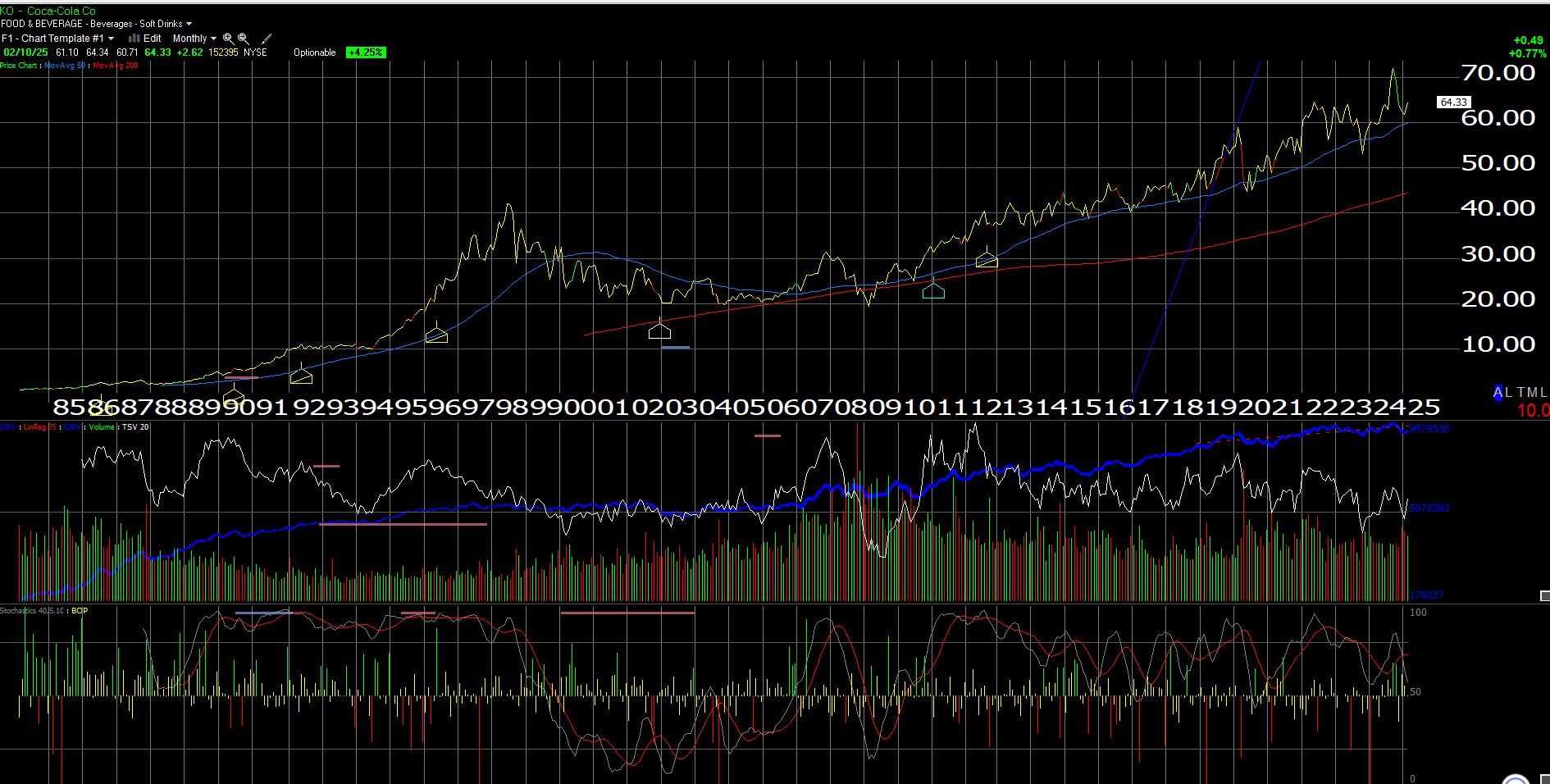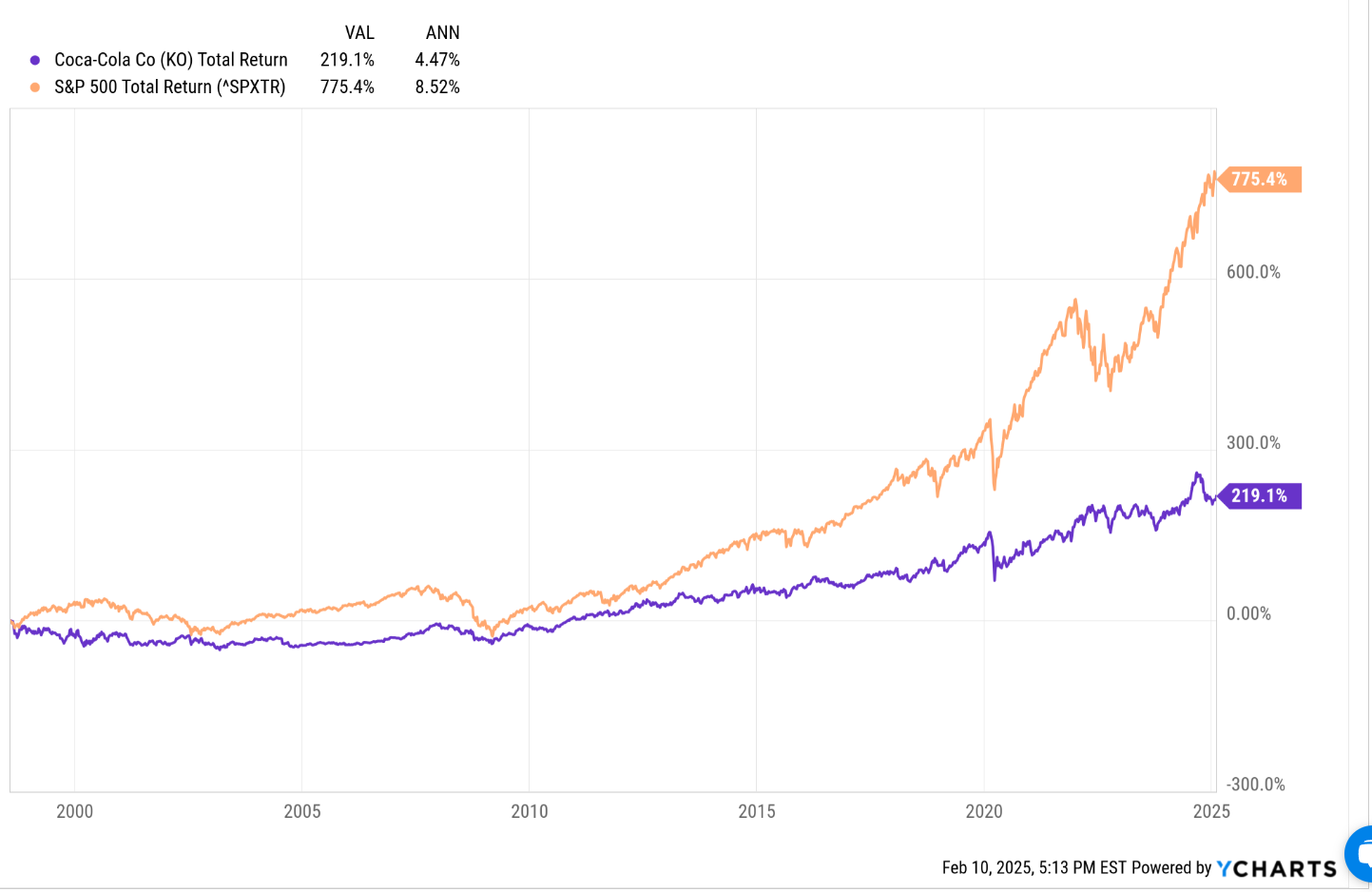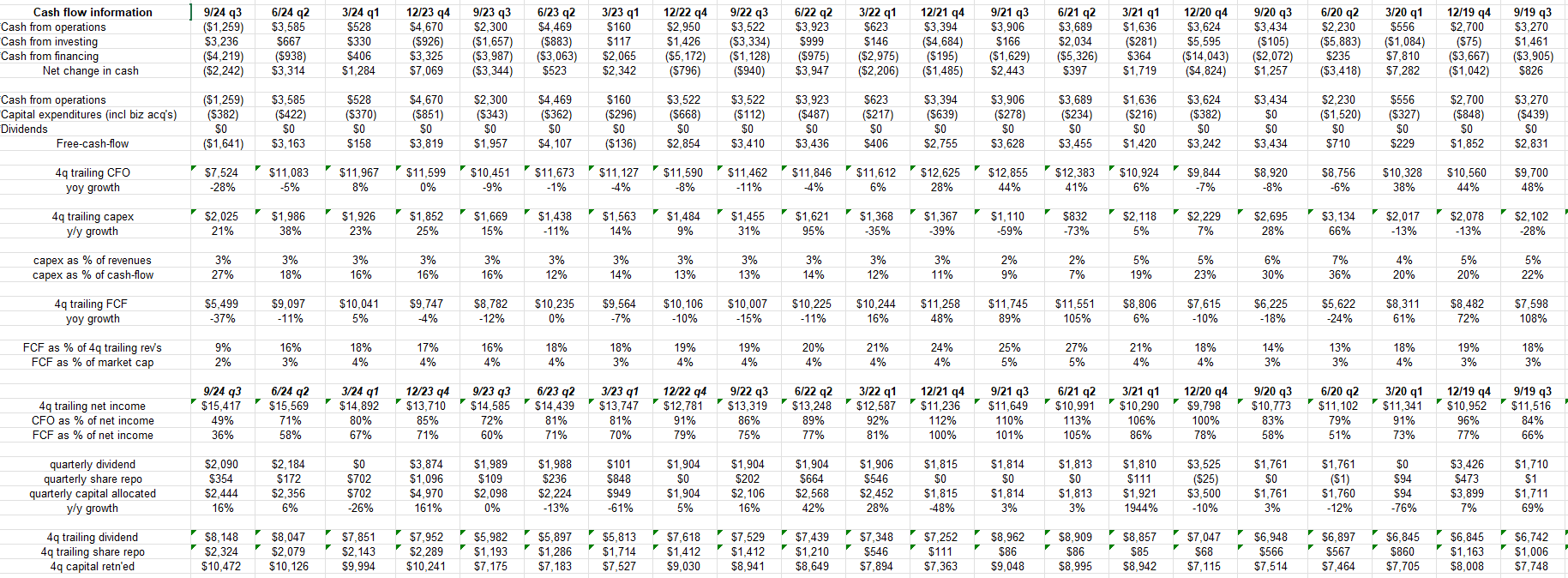By the time most readers see this, Coca-Cola (NYSE:KO), the beverage giant that still remains a large holding at Warren Buffett’s Berkshire Hathaway (NYSE:BRKa), will have reported their q4 ’24 financial results on Tuesday morning, February 11th, 2025, before the opening bell.
Consensus estimates expect Coke to print $0.52 in EPS, $10.68 billion in revenue and $2.67 billion in operating income, for expected y-o-y growth of +6%, -2% and +5%.
Coke has long been a low-to-mid-single digit secular across most metrics. The soda giant was disrupted badly by Red Bull, the various energy drinks, and many other derivations of the traditional soda brands in the last 20 years, and under the current CEO James Quincey, has started to catch up.
The stock actually peaked in late July, 1998, just as the LongTerm Capital Management was breaking, which also seemed to coincide with a Russian debt default, resulting in the Nasdaq 100 dropping 30% – 35% between late July ’98 and early October, ’98.
On this monthly chart, readers can see the July ’98 peak, which really wasn’t exceeded until 2016, 2017, and the stock has still managed to underperform since that time.
Since the ’98 peak, Coke has had a few CEO’s that never really moved the stock price, but Coke did decide to spin-off the bottling operation in early part of last decade (2010 – 2019) which it finally accomplished about the time the stock started making new all-time-highs.
Here’s the issue:
Looking at the above spreadsheet, at the left-hand column, the three rows that are 3 clusters higher from the bottom, just under the quarterly date reminder, where the reader will see “CFO as % of net income”, and then “FCF as % of net income”.
This is the traditional earnings quality test this blog uses to evaluate – well – earnings quality.
If readers are wondering where I picked this up, it was no less than Enron, in the late 1990’s. At that time, there was an analyst in the Merrill Lynch Houston office, who put out a sell rating on Enron in the grand euphoria of that 5-year period in the late 1990’s and Ken Lay, being the CEO or Chairman of Enron and a big deal in the Houston business community, managed to get the Merrill Lynch analyst fired.
Ultimately, Bethany McLean, and Jim Chanos of Kynikos Associates (Jim’s firm shorted Enron’s stock well before it traded to $0 in 2000) garnered some notoriety after writing the so-called book on Enron’s demise, but the Merrill Lynch analyst was the poor kid who really was first to recognize what was happening within Enron.
That analyst used the “net income to cash-flow” test and decided something was amiss at Enron.
That being said, Coca-Cola is no Enron, but for a numbers and accounting geek like me who always tries to evaluate quality of earnings of every long-term client holding (usually before it becomes a long-term holding), comparing TTM (trailing twelve-month net income) net income to TTM cash-flow-from ops (CFO) and TTM free-cash-flow (FCF) seems as good a litmus test as any.
Is this earnings quality a threat to Coke’s longevity or business model? No, that’s unlikely. It simply gives readers a litmus test to compare net income versus cash-flow, and to be frank, most companies tend to generate more cash-from-operations than net income, and usually free-cash-flow tends to – in most cases – be pretty close to 100% of net income.
The one aspect of this that accountants or analysts who are very familiar with statements of cash-flow can probably spot, is that capital-intensive businesses generate significant depreciation, which can make cash-flow-from-operations look better than it is. Depreciation is a non-cash expense and is added back to net income to derive cash-flow-from-operations, hence for manufacturing and capital-intensive businesses (like semiconductor companies, which is what killed Intel (NASDAQ:INTC)), analysts are better off not adding back the depreciation, or at least adjusting for it, to arrive at cash-from-operations.
Conclusion:
Coca-Cola (KO) could be up $5 after reporting earnings tomorrow morning, so this article isn’t any kind of recommendation or suggestion on buying or holding or selling the shares.
Part of the weakness in cash-flow from ops, could be the lack of any healthy secular growth in the majority of it’s product lines, but James Quincey has been trying to remedy that. James tried to get a cannabis-based product going at Coca-Cola, but I thought that Berkshire Hathaway shot it down. Coca-Cola launched their first alcoholic beverage product within the last few years, which I’m guessing is a new market for the carbonated soft-drink giant, but a market like that takes years to develop.
When the bottling operation was divested in 2016 – 2017 (?) the goal was to make the business less capital-intensive, and expand margins. 8, 9, 10 years later Coke still struggles which is probably a function of neglecting the brands from 2000 through 2009, and then ignoring the numerous disruptive new products that hit the market in the last 25 years.
There was a $6 billion tax deposit for litigation that was absorbed last quarter, and that supposedly crushed cash-flow, which as you can see on the spreadsheet was a negative $1.2 billion for Q3 ’24, versus the prior year Q3 ’23 of $2.3 billion.
However, looking at the above spreadsheet, even if we cut-off at the June ’24 quarter, and look TTM EPS for KO, as of June, 2024, that account EPS number was $3.27 per share. If we then calculate TTM cash-flow per share (found on another part of the spreadsheet, not shown), the amount is $1.74 per share. If we did the same for TTM free-cash-flow, the number is $1.27 per share.
This blog never followed Pepsi (NASDAQ:PEP) and stopped following Procter & Gamble (NYSE:PG) years ago. The only consumer staple that’s held by clients today, and has become a sizable position is Walmart (NYSE:WMT). The emergence of AI and Walmart adopting the “flywheel” approach to it’s $700 billion in annual revenue has certainly helped the stock.
However, this blog applies the same exact measures to WMT as it does to Coke and here are the results:
- Walmart’s TTM net income is covered by TTM cash-flow by 219% (as of the October ’24 quarter)
- Walmart’s TTM net income is covered by TTM free-cash-flow by 109% (as of the October ’24 quarter, and this percentage can vary greatly)
- TTM Walmart EPS: $2.45
- TTM Walmart cash-flow per share: $5.62
- TTM Walmart free-cash per share: $2.81
As the reader can tell Walmart’s cash earnings are greater than the accounting earnings, not a bad thing to see in terms of earnings quality.
So, what are KO’s true earnings per share? Probably somewhere in between the accounting EPS and the cash-flow EPS. How does KO negotiate this for shareholders? Long-term debt issuance issuance seems reasonable so KO has plenty of liquidity, with an A+/A1 S&P/Moody’s senior unsecured credit rating(s), per LSEG. It’s hopefully a temporary issue for the beverage giant, but at the typical speed at which KO moves, hopefully, it will be resolved by the end of the decade.
80% of the capital return to shareholders is the dividend since KO just doesn’t buy back that much stock anymore. Looking at the cash-flow statement, you can see why. Hopefully, that will change, too.
If Berkshire Hathaway still maintains a sizable position as it has, it’s probably not anything to worry about.
Again, none of this is to disparage a great brand. I just wish their quality of earnings were better. I’d love to buy the stock for clients again, just need this discrepancy to start to go away.
Disclaimer: None of this is advice or a recommendation, but only an opinion. Past performance is no guarantee of future results. Investing can and does involve the loss of principal, even for short periods of time. All spreadsheet data is sourced internally from earnings reports, annual reports and 10-Q’s.
Thanks for reading.
